Boris Johnson is now the
United Kingdom’s Prime Minister and he has promised to lead the UK out of the European
Union by October 31st. He
insists that he can get the European Union to renegotiate the deal even though
the Europeans are adamant that the deal negotiated with Teresa May is a take it
or leave it proposition. And if they do
not renegotiate, then Johnson is also quite strident that Britain will leave no
matter what. As a result, all of this will likely lead to a quite disruptive and erratic
next few months as Britain and the EU try to sort out the remainder of Brexit.
Based on these positions,
it would appear that the outcome by October 31st is assured –
Britain will leave the EU without a deal and sail off on its separate way.
On the other hand, politics is a strange process with a lot of dramatic posturing and one could very well
see a new deal emerge. Or, in what could
be a really bizarre turn of events, Britain could very well stay in the
EU. Just as only Nixon could go to
China, only Boris could actually keep Britain in the EU.
Much of the discussion
of the entire Brexit issue has focused on how chaotic and disruptive it has
been and how damaging it is to Britain’s long-term economic and political
interests. However, there may be some
reason behind this madness if one is to take the writings of Winston Churchill
on foreign policy and extrapolate them to the present. In his first volume of his epic history of
the Second World War, Churchill writes the following:
“For four hundred years the foreign policy of England has been to oppose
the strongest, most aggressive, most dominating Power on the Continent, and
particularly to prevent the Low countries falling into the hands of such a
Power…we always took the harder course, joined with the less strong Powers,
made a combination among them, and thus defeated and frustrated the Continental
military tyrant…Thus we preserved the liberties of Europe, protected the growth
of its vivacious and varied society, emerged after four terrible struggles with
an ever-growing fame and widening Empire…Here is the wonderful unconscious tradition
of British Foreign Policy…Observe that the policy of England takes no account
of which nation it is that seeks the overlordship of Europe…it is concerned
solely with whoever is the strongest or the potentially dominating tyrant.”
Well, there you have
it. Britain’s elites and particularly those
in the Conservative Party appear to be - borrowing from the words of Keynes -
the unwitting slaves of some now defunct foreign policy prescription that
guided the rise to empire. Boris Johnson
and the Brexiteers do not view the dominant European power as Germany, France
or Spain but the grand project of European union and its bureaucracy in
Brussels is now the continental tyrant. By leaving the EU, they see
themselves as safeguarding the freedom of Britain and sowing disruption that
might lead to the eventual breakup of the EU.
Of course, one might
ask why they joined? Well, as the European
Project was coming together after 1950, it gradually became apparent that it
was not falling apart and would continue.
So, being on the inside would have been the best way to keep an eye on
things and steer things according to Britain’s interests. Indeed, being on the inside and “unconsciously”
provocative or disruptive could be seen as a potential policy direction given
hundreds of years of British foreign policy geared towards keeping Europe apart. Indeed, French President Charles De Gaulle’s
opposition to British membership can be viewed as a realization of this.
Why leave now? Well,
the “unconscious” hope was that given the strains the EU was undergoing in the
wake of the 2008-09 financial crisis and the migrant crisis, leaving now might
be the final push leading to its break-up.
However, the miscalculation here was that it is no longer 1789 or 1913
or 1939. It is the early 21st
century and Britain’s actions have interestingly enough galvanized the
Europeans at least for the time being into working harder to stay
together. Boris and the Brexiteers and
their “unconscious” policy formulation may backfire big-time.




